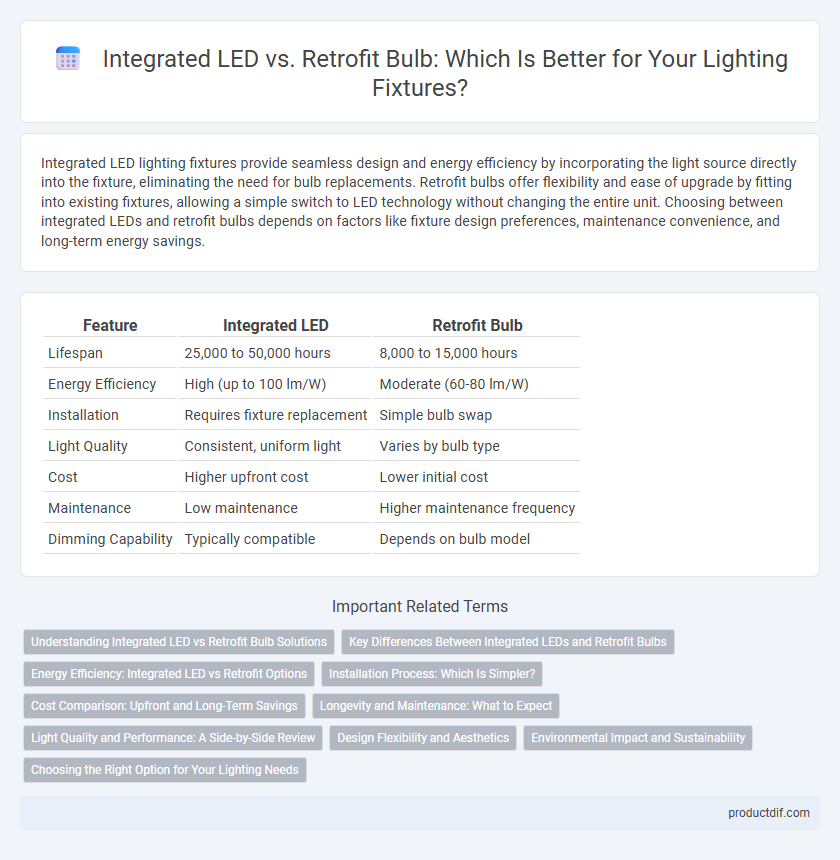Integrated LED lighting fixtures provide seamless design and energy efficiency by incorporating the light source directly into the fixture, eliminating the need for bulb replacements. Retrofit bulbs offer flexibility and ease of upgrade by fitting into existing fixtures, allowing a simple switch to LED technology without changing the entire unit. Choosing between integrated LEDs and retrofit bulbs depends on factors like fixture design preferences, maintenance convenience, and long-term energy savings.
Table of Comparison
| Feature | Integrated LED | Retrofit Bulb |
|---|---|---|
| Lifespan | 25,000 to 50,000 hours | 8,000 to 15,000 hours |
| Energy Efficiency | High (up to 100 lm/W) | Moderate (60-80 lm/W) |
| Installation | Requires fixture replacement | Simple bulb swap |
| Light Quality | Consistent, uniform light | Varies by bulb type |
| Cost | Higher upfront cost | Lower initial cost |
| Maintenance | Low maintenance | Higher maintenance frequency |
| Dimming Capability | Typically compatible | Depends on bulb model |
Understanding Integrated LED vs Retrofit Bulb Solutions
Integrated LED lighting fixtures combine LEDs directly into the design, offering improved energy efficiency, longer lifespan, and streamlined aesthetics without the need for bulb replacement. Retrofit bulbs fit into existing fixtures, providing a cost-effective way to upgrade traditional lighting to LED without altering the fixture itself but may offer less optimized performance compared to integrated solutions. Choosing between integrated LEDs and retrofit bulbs depends on factors such as installation costs, desired lifespan, energy savings, and fixture compatibility.
Key Differences Between Integrated LEDs and Retrofit Bulbs
Integrated LED fixtures feature built-in LED modules designed specifically for the luminaire, ensuring optimal performance, energy efficiency, and longevity. Retrofit bulbs are traditional light bulbs fitted with LED technology, allowing them to replace incandescent or fluorescent bulbs without changing the fixture, but they may not deliver the same efficiency or lifespan as integrated options. Key differences include heat dissipation, design flexibility, maintenance costs, and compatibility with existing fixtures, where integrated LEDs generally offer superior reliability and light quality.
Energy Efficiency: Integrated LED vs Retrofit Options
Integrated LED lighting fixtures offer superior energy efficiency by utilizing advanced semiconductor technology that converts a higher percentage of electricity into light, reducing wattage consumption compared to retrofit bulbs. Retrofit LED bulbs, while more energy-efficient than traditional incandescent or fluorescent bulbs, often have limitations in heat dissipation and luminous efficacy due to compatibility constraints with existing fixture designs. The enhanced thermal management and optimized circuitry of integrated LEDs result in longer lifespans and lower energy bills, making them a more sustainable choice for residential and commercial lighting applications.
Installation Process: Which Is Simpler?
Integrated LED fixtures offer a streamlined installation by combining the light source and housing into a single unit, eliminating the need for separate bulb replacement. Retrofit bulbs require compatibility with existing fixtures but allow quick swaps without rewiring or fixture changes, making them convenient for upgrade projects. The installation simplicity depends on whether a completely new fixture or a bulb replacement is preferred, with integrated LEDs favoring new installations and retrofit bulbs ideal for easy upgrades.
Cost Comparison: Upfront and Long-Term Savings
Integrated LED lighting fixtures typically have a higher upfront cost compared to retrofit bulbs but offer significant long-term savings due to lower energy consumption and extended lifespan. Retrofit bulbs provide a lower initial investment by converting existing fixtures, but they may increase maintenance and replacement expenses over time. Evaluating total cost of ownership, including installation, energy, and replacement costs, reveals integrated LEDs as a more cost-effective solution in the long run.
Longevity and Maintenance: What to Expect
Integrated LED lighting fixtures offer superior longevity, often exceeding 50,000 hours of continuous use, reducing replacement frequency significantly compared to retrofit bulbs. Retrofit LED bulbs typically last between 15,000 to 25,000 hours, necessitating more frequent maintenance and replacements. The sealed design of integrated LEDs also minimizes dust and moisture exposure, resulting in lower maintenance costs and enhanced durability over time.
Light Quality and Performance: A Side-by-Side Review
Integrated LED fixtures deliver superior light quality with consistent color temperature and minimal glare due to their optimized design, enhancing visual comfort and energy efficiency. Retrofit bulbs often experience limitations in heat dissipation and beam angle, resulting in uneven illumination and reduced longevity compared to integrated LEDs. Performance-wise, integrated LED systems offer higher lumen maintenance and better energy savings, making them a more reliable choice for long-term lighting solutions.
Design Flexibility and Aesthetics
Integrated LED lighting fixtures offer superior design flexibility by allowing seamless incorporation into architectural elements, enabling sleek, minimalist aesthetics. Retrofit bulbs, while easier to install in existing fixtures, often limit design innovation due to standardized shapes and sizes. Choosing integrated LEDs enhances customized lighting solutions and modern visual appeal without compromising fixture form.
Environmental Impact and Sustainability
Integrated LED lighting fixtures offer superior environmental benefits by reducing energy consumption by up to 80% compared to traditional retrofit bulbs, which often contain hazardous materials like mercury. The longer lifespan of integrated LEDs, typically exceeding 50,000 hours, minimizes waste and lowers replacement frequency, contributing to sustainable practices. Retrofit bulbs, while easier to install, generally have lower energy efficiency and shorter lifespans, leading to increased environmental impact over their usage cycle.
Choosing the Right Option for Your Lighting Needs
Integrated LED lighting fixtures offer superior energy efficiency, longer lifespan, and sleek designs compared to retrofit bulbs, which simply replace traditional lamps in existing fixtures. Retrofit bulbs provide flexibility and ease of installation without needing to change the entire fixture, making them ideal for upgrading older lighting systems quickly. Assessing factors such as installation complexity, budget, desired longevity, and light quality will guide you in choosing between integrated LED fixtures and retrofit bulbs for optimal lighting solutions.
Integrated LED vs Retrofit Bulb Infographic

 productdif.com
productdif.com